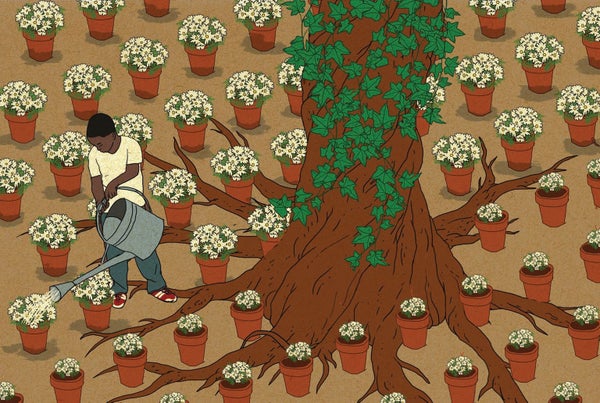One of the big academic stories of 2023 was the U.S. Supreme Court's decision to end the use of race as a criterion in college admissions. The ruling was based on two cases that made their way to the high court, one focused on Harvard University and the other on the University of North Carolina.
Most of the media attention and commentary centered on Harvard. Former president Barack Obama, who attended Harvard Law School, defended the university's policies as allowing Black students to prove that “we more than deserved a seat at the table.” Michelle Obama, who also attended Harvard Law School, wrote that her heart was breaking for “any young person out there who's wondering what their future holds—and what kind of chances will be open to them.” Reporting on an analysis of admissions data, the New York Times noted the many ways that Harvard continued to be a bastion of privilege whose admissions criteria “amounted to affirmative action for the children of the 1 percent.”
The focus on Harvard was misplaced, however. If the issues at stake are opportunity and its role in a democratic polity, then our focus should be on supporting and strengthening the public university system. Of the 14 million American students in four-year schools, about two thirds are in public schools, where the ethnic and racial makeup is much closer to the overall undergraduate population than it is at private schools, as well as close to the U.S. population in general. In these schools the largest obstacle to advancement is cost.
On supporting science journalism
If you're enjoying this article, consider supporting our award-winning journalism by subscribing. By purchasing a subscription you are helping to ensure the future of impactful stories about the discoveries and ideas shaping our world today.
The past decades have seen huge increases in costs at public institutions of higher education. Measured in constant dollars, in the 1963–1964 academic year, tuition, room and board at four-year public institutions was $8,491. By 2021–2022 that figure was $21,878—almost three times as high. Declining state support is a major contributor to rising fees—and not just in “red” states. At the University of California, San Diego—where I taught for many years—the share of revenues that came from state support declined from 32 percent in 2002 to 15 percent in 2020; similar patterns can be found broadly. According to the National Education Association, “across the U.S., 32 states spent less on public colleges and universities in 2020 than in 2008, with an average decline of nearly $1,500 per student. As a result, students need to pay (and borrow) more.”
In the wake of the COVID pandemic, some states have increased their support, but overall, funding for public colleges dropped 9.1 percent from 2008 to 2018. The net effects of decreased public funding are an increased burden on students and, except for the very wealthy, diminished educational opportunities.
Budget cuts don't lead just to higher fees, which some students could perhaps address by working more hours in the dining hall or borrowing more money. Underfunding also results in fewer career options. West Virginia University recently announced that, because of budget cuts, it will no longer teach world languages and creative writing, curtailing options for students hoping for careers in foreign service, immigration law, journalism, and many other fields. Furthermore, underfunding leads state officials (and sometimes, in response, university administrators) to promote a narrow, vocationally oriented view of education, which further restricts students' options.
In 1970 most jobs did not require a college degree. Today nearly all well-paying ones do. With the rise of artificial intelligence and the continued outsourcing of low-skilled and de-skilled jobs overseas, that trend most likely will accelerate. Those who care about equity of opportunity should pay less attention to the lucky few who get into Harvard or other highly selective private schools and more to public education, because for most Americans, the road to opportunity runs through public schools.
This is an opinion and analysis article, and the views expressed by the author or authors are not necessarily those of Scientific American.
